MANAGING PALMOPLANTAR DISORDERS
Palmoplantar pustulosis
Palmoplantar pustulosis is a chronic pustular condition affecting the palms and soles.
What is the cause of palmoplantar pustulosis?
The exact cause of palmoplantar pustulosis is unknown. It appears to be a disorder of the eccrine sweat glands, which are most numerous on palms and soles.
Palmoplantar pustulosis is probably autoimmune in origin (‘self allergy’), as there is an association with other autoimmune diseases particularly gluten sensitive enteropathy (celiac disease), thyroid disease and type 2 diabetes.
Palmoplantar pustulosis was previously considered to be a localised form of pustular psoriasis but about 10-20% of patients with palmoplantar pustulosis have psoriasis elsewhere. It is now known that they are distinct conditions with different genetic backgrounds.
Genetic factors account for family members having the disease. However, it rarely occurs before adulthood. It is more common in women than men.
Palmoplantar pustulosis is much more common in current smokers (and in those that have smoked in the past). It is thought that activated nicotine receptors in the sweat glands cause an inflammatory process.
Dermatitis, particularly pompholyx, and tinea pedis (a fungus infection) may appear similar, but require different treatment.
Palmoplantar pustulosis
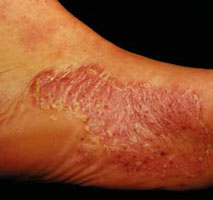
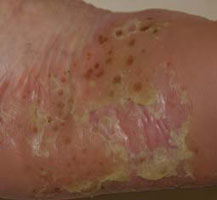
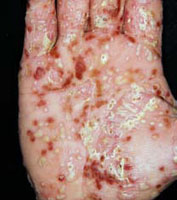
Palmoplantar pustulosis presents as crops of sterile pustules occurring on one or both hands and/or feet. They are associated with thickened, scaly, red skin which easily develops painful cracks (fissures).
The condition varies in severity and may persist for many years. It is not known what causes exacerbations or remissions. Palmoplantar pustulosis is not infectious to other people and does not influence one’s general health. However the discomfort can be considerable, interfering with working and leisure activities.
Walking for prolonged periods may cause exacerbations on the feet. If the palms are involved, manual activities may be uncomfortable, and injuries may aggravate the disorder. Certain occupations are therefore inadvisable for affected individuals.
Treatment
Treatment does not cure the disorder and is not always successful. The following may be helpful.
General Measures
- If you smoke, try to stop: however, palmoplantar pustulosis may take several months to improve.
- Choose comfortable footwear made from natural fibres.
- Avoid friction and minor injuries.
- Cover deep fissures with a waterproof dressing.
- Rest the affected area.
- If flares appear related to tonsillitis, consider tonsillectomy.
Emollients
- Use plenty of grease or other thick emollient to soften the dry skin to prevent fissures.
- Soak in warm water with emulsifying ointment for 10 minutes.
- Apply white soft paraffin liberally
- Use salicylic acid ointment or urea cream (heel balm) to peel off dead skin (may sting).
- Wash with bath oil or soap substitute.
Topical Steroids
Topical steroids are anti-inflammatory agents which range in potency and vehicle. Only the strongest ointments are effective in conditions affecting the thick skin of the hands and feet.
However the very potent products such as clobetasol proprionate should be used only for limited periods or else side effects and loss of efficacy become a problem.
A thin smear should be applied twice daily to the affected area. The effect may be enhanced by using plastic occlusion for a few hours or even overnight – use polythene gloves, plastic bags or cling film. Do not use occlusion for more than 5 days in a row.
Coal Tar
Crude coal tar is very messy but applied directly to the pustules every five days or so can stop them occurring. Paint on carefully and cover. It can be mixed in an ointment base for easier application.
Acitretin
Novatretin capsules, derived from Vitamin A, can control palmoplantar pustulosis in the majority of users.
PUVA
Ultraviolet radiation, especially in combination with psoralens taken as tablets or applied topically (bathwater PUVA), can be effective. PUVA particularly in combination with Novatretin (Re-PUVA) can also be effective. Careful medical supervision is necessary to avoid burning.
Other
A variety of other medications can help some subjects including:
- Colchicine
- Dapsone
- Methotrexate
- Tetracycline antibiotics
- Ciclosporin
Biologics are occasionally effective when used for severe palmoplantar psoriasis.
Palmoplantar keratoderma
What is keratoderma?
‘Keratoderma’ is a term that means marked thickening of the skin.
‘Palmoplantar’ refers to the skin on the soles of the feet and palms of the hands; these are the areas keratoderma affects most often. Palmoplantar keratoderma is also sometimes known as ‘keratosis palmaris et plantaris’.
Classification of keratoderma depends on whether or not it is inherited, and its clinical features.
Diffuse keratodermas affect most of the palms and soles.
Focal keratodermas mainly affect pressure areas.
Punctate-type keratodermas result in tiny bumps on the palms and soles.
Most often the abnormal skin involves only the palms and soles (non-transgradient) but sometimes it extends on to the top of the hands and feet as well (transgradient).
In some rare forms of keratoderma, other organs in the body may be affected in addition to the skin, and the keratoderma can be a marker of this internal abnormality.
Palmoplantar keratoderma
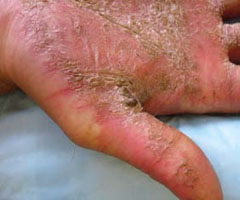
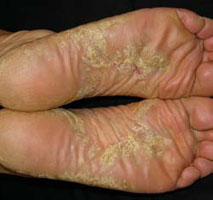
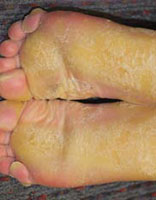
What causes palmoplantar keratoderma?
Keratoderma may be inherited (hereditary) or, more commonly, acquired.
Hereditary keratoderma: the condition runs in families and is passed down from one or both parent(s) to their children
Acquired keratoderma: the condition is not inherited and occurs as a result of a change in the health or the environment of the affected person
The hereditary keratodermas are caused by a gene abnormality that results in abnormal skin protein (keratin). They may be inherited either by an autosomal dominant or autosomal recessive pattern.
Autosomal dominant keratodermas are likely to occur in every generation of a family. If one parent is affected there is a 50% chance that each child will be affected.
Autosomal recessive keratodermas occur less commonly within an affected family. This is because both parents need to pass on an abnormal gene to the child for it to be affected.
People with one affected gene only do not have the condition themselves but carry the abnormal gene and are referred to as ‘carriers’ of the disease. They may pass on the abnormal gene to their children but the children will only be affected if their other parent also carries an abnormal gene and passes it on to the same child.
Treatment of palmoplantar keratoderma
The following treatments soften the thickened skin and make it less noticeable.
- Emollients
- Keratolytics (e.g. 6% salicylic acid in 70% propylene glycol)
- Topical retinoids
- Topical vitamin D ointment (calcipotriol)
- Systemic retinoids (acitretin)